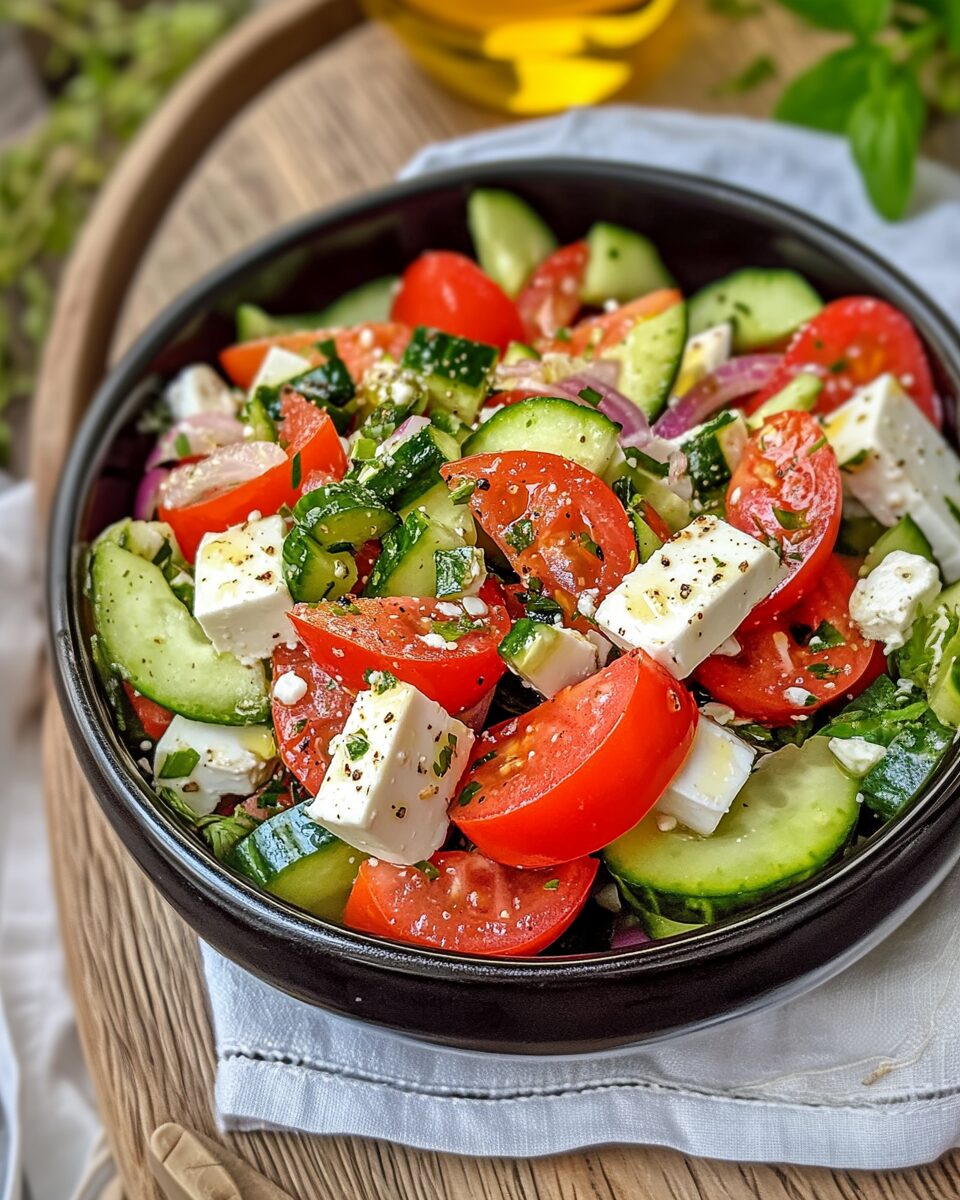Horiatiki Salad, also known as Greek Village Salad, is a traditional Greek dish that embodies the freshness and simplicity of Mediterranean cuisine. This vibrant salad combines ripe tomatoes, crisp cucumbers, green bell peppers, red onions, Kalamata olives, and creamy feta cheese, all brought together with a drizzle of extra virgin olive oil and a sprinkle of oregano. It’s a staple in Greek households, celebrated for its wholesome ingredients and delightful flavors.
Full Recipe:
Ingredients
-
2 ripe tomatoes, chopped
-
½ English cucumber, sliced
-
½ green bell pepper, sliced
-
½ cup red onion, sliced
-
½ cup Kalamata olives
-
4–6 ounces feta cheese (planks, crumbles, or cubes)
-
2 tablespoons extra virgin olive oil
-
1 tablespoon red wine vinegar
-
2 teaspoons dried oregano
-
Salt and pepper, to taste
Directions
-
Chop the tomatoes into bite-sized pieces. Slice the cucumber and green bell pepper into thin slices, and thinly slice the red onion.
-
In a large salad bowl, combine the chopped tomatoes, sliced cucumber, bell pepper, red onion, and Kalamata olives.
-
In a small bowl, whisk together the extra virgin olive oil, red wine vinegar, and dried oregano. Drizzle this dressing over the vegetables and toss gently to ensure all ingredients are evenly coated.
-
Arrange the feta cheese on top of the salad, either in planks, crumbles, or cubes, according to your preference.
-
Sprinkle a bit more oregano over the feta for added flavor. Season the salad with salt and pepper to taste.
-
Let the salad sit for about 20 minutes before serving to allow the flavors to meld together beautifully.
Nutritional Facts
Per serving (approximately 1 cup):
-
Calories: 193 kcal
-
Carbohydrates: 9g
-
Protein: 5g
-
Fat: 16g
-
Saturated Fat: 5g
-
Polyunsaturated Fat: 1g
-
Monounsaturated Fat: 8g
-
Cholesterol: 25mg
-
Sodium: 592mg
-
Potassium: 295mg
-
Fiber: 3g
-
Sugar: 4g
-
Vitamin A: 810 IU
-
Vitamin C: 23mg
-
Calcium: 183mg
-
Iron: 1mg
Origins and History of Horiatiki Salad
The history of Horiatiki Salad is deeply intertwined with Greece’s agricultural traditions. The ingredients used in the salad reflect the bounty of the Mediterranean region, where olive trees, vineyards, and vegetable gardens are in abundance. The word “Horiatiki” translates to “village” in Greek, indicating that this salad was once a dish enjoyed by villagers, made with ingredients that were locally available and easily sourced.
The salad’s simplicity reflects the Greek philosophy of cooking: using quality ingredients and letting their natural flavors shine. In ancient Greece, the diet was largely plant-based, with a heavy reliance on fruits, vegetables, legumes, and olive oil. Over time, as Greece’s influence spread through the Mediterranean, this dish became a symbol of Greek culture, enjoyed not just in homes but in tavernas and restaurants worldwide.
Ingredients and Their Health Benefits
While the exact ingredients of Horiatiki Salad can vary slightly depending on the region and personal preferences, the core components remain the same. The salad’s base includes ripe tomatoes, cucumbers, green peppers, red onions, Kalamata olives, and feta cheese, all dressed with extra virgin olive oil and seasoned with oregano, salt, and pepper.
Each of these ingredients offers unique health benefits, making the Horiatiki Salad not only a delicious dish but also a nutritious one. Tomatoes, for example, are rich in antioxidants, particularly lycopene, which is known for its heart-healthy properties and ability to reduce the risk of certain cancers. Cucumbers provide hydration due to their high water content and offer a refreshing crunch. Green peppers are loaded with vitamin C, which supports immune health, and red onions have anti-inflammatory properties that promote overall wellness.
The Kalamata olives used in this salad are packed with healthy monounsaturated fats, which are known to support heart health and lower cholesterol. Feta cheese, the crown jewel of this dish, is made from sheep or goat milk and provides a good source of calcium, which is essential for strong bones and teeth. The extra virgin olive oil used to dress the salad is a hallmark of Mediterranean diets, known for its anti-inflammatory properties and its ability to reduce the risk of chronic diseases.
Nutritional Benefits of Horiatiki Salad
The nutritional profile of Horiatiki Salad makes it an excellent choice for anyone looking to eat healthy without sacrificing flavor. It is low in calories, with most of its energy coming from healthy fats provided by the olive oil and olives. The high content of vegetables in the salad ensures that it is rich in vitamins, minerals, and dietary fiber.
A key benefit of Horiatiki Salad is its ability to provide a good balance of macronutrients. The monounsaturated fats from the olive oil and olives are heart-healthy and have been shown to help reduce bad cholesterol levels. These healthy fats, combined with the high fiber content from the vegetables, make the salad a filling and satisfying dish that can help regulate blood sugar levels and promote digestive health.
The vitamins and minerals in the salad further enhance its nutritional value. Vitamin C from the green peppers and tomatoes boosts the immune system and supports skin health, while the potassium in the olives and cucumbers helps maintain healthy blood pressure levels. Feta cheese provides calcium for bone health, and the antioxidants in the tomatoes help fight free radicals in the body, which can damage cells and accelerate the aging process.
Serving and Pairing Suggestions
Horiatiki Salad is incredibly versatile and can be served in a variety of ways. It pairs wonderfully with a wide range of Mediterranean dishes, making it an ideal side dish or appetizer for a Greek-themed meal. Serve it alongside grilled meats like lamb, chicken, or fish, or pair it with warm, crusty bread for a simple, satisfying meal. It also works well as a light lunch when served with a side of hummus or tzatziki.
For a more substantial meal, consider adding protein-rich ingredients such as grilled chicken, shrimp, or chickpeas. The salad’s crisp, fresh flavors provide a refreshing contrast to the savory richness of the protein, creating a balanced meal that is both filling and nutritious.
If you’re hosting a gathering or family meal, Horiatiki Salad is a great addition to any spread. It’s easy to prepare in large quantities and can be made ahead of time, allowing the flavors to meld together. The salad is best served at room temperature, so if you’re preparing it in advance, be sure to let it sit for a bit before serving to allow the flavors to come to life.
Cultural Significance of Horiatiki Salad
In Greece, food is more than just sustenance – it is a central part of social life and cultural traditions. Meals are often shared with family and friends, and the Mediterranean diet is known for its focus on community, health, and longevity. Horiatiki Salad is a perfect example of this philosophy, as it is a dish that brings people together around the table to enjoy fresh, wholesome food.
The salad is often eaten during the warmer months when fresh produce is abundant, but it is also a dish that can be enjoyed year-round. In Greek culture, meals are often leisurely affairs that involve multiple courses, and Horiatiki Salad is typically served as the first course, followed by grilled meats, seafood, or a variety of mezzes (small dishes). The salad is also a popular choice for picnics and outdoor gatherings, as it is easy to transport and can be enjoyed at room temperature.
Conclusion
Horiatiki Salad is more than just a dish – it is a celebration of Greek culture, Mediterranean ingredients, and the timeless tradition of healthy eating. Its vibrant colors, fresh flavors, and nutritional benefits make it a perfect choice for anyone looking to enjoy a light, healthy meal that is full of flavor. Whether you’re preparing it as a side dish, a light lunch, or as part of a larger Mediterranean feast, Horiatiki Salad will never disappoint.






